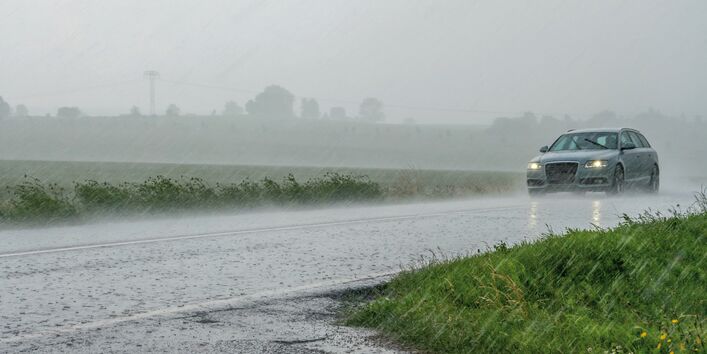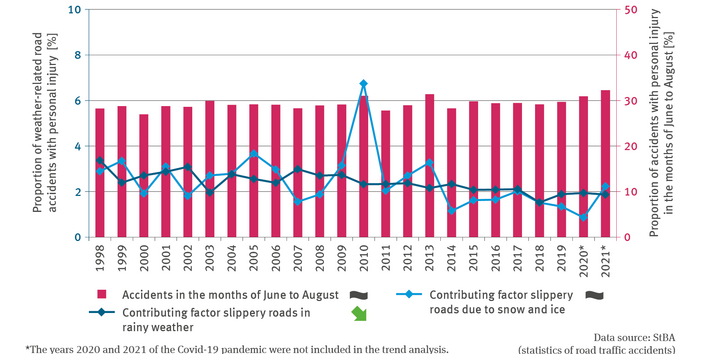Road safety and accident scenarios on Germany’s roads depend on numerous factors of influence. Apart from the existing infrastructure as well as the density and structure of traffic and the behaviour of road users, these also include the weather and prevailing weather patterns. Rain and snow, as well as ice and hailstones impact road conditions, making for adverse driving conditions such as aquaplaning or slippery roads, also on pavements and cycle lanes. Precipitation and fog reduce visibility. The risk of accidents is therefore usually greater in the autumn and winter months than in spring and summer. Overall, there are more accidents in those months. However, as road users tend to adjust their speeds to hazardous conditions, there are fewer accidents causing personal injury during that time than in the warmer months. This situation is furthermore influenced by the choice of one’s mode of transport: Humans prefer travelling by car or public transport. The latter reduces the number of unprotected and particularly vulnerable road users from exposure to road traffic.
During the warm season, it is possible to observe contrary behavioural patterns. People make use of pleasant temperatures and longer days. They move about more in public spaces and do more errands on foot or by means of a bicycle, e-bike or motorbike. Traffic situations are becoming generally more complex while the proportion of more vulnerable road users is increasing. Moreover, in good, dry weather road users with power-driven vehicles tend to drive faster than in slippery or wet road conditions, thus provoking more serious accidents. Although over the summer months the number of accidents – compared to the year as a whole – is average, the proportion of accidents where people are injured or killed is particularly high at that time of year.
The accident situation in 2010 as assessed by the Federal Statistical Office (StBA)168 demonstrates the various ways in which the weather and weather patterns can affect road safety. During the months of January, February and December, the prevailing road conditions tended to be very wintry. As a result, snow and black ice were joint causes of almost twice as many accidents involving personal injury as in other years during the period in question. However, the overall picture shows that in those months (as indeed throughout 2010) there were comparatively few accidents involving personal injury so that in those months the relative proportion of accidents involving personal injury was the lowest since 1991. Overall, the number of accidents was much higher, but thanks to basically more cautious driving, the accidents involved only material damage. By contrast, the proportion of accidents involving personal injury reached an above-average high level in the summer months of 2010 and 2013. As far as 2010 is concerned, part of the blame can be apportioned to the weather, because June and July of that year were generally very sunny while the first weeks of July were very hot. Compared to the past ten years, there were overall fewer accidents in 2013 involving personal injury. The relatively hot July of 2013 was, in fact, the most accident-prone month of the entire period examined and it accounts for the high proportion of accidents in the summer months of that year. The increase in 2020 and 2021 should be categorised as a side effect of the Covid-19 pandemic. Owing to the introduction of less stringent regulations in the summer months, and compared to pre-pandemic times, the decline in accident figures was less distinct in the months from June to August than in most of the months of those years. This is reflected in the higher proportion of summer months compared to the annual accident situation.
In view of the influence which weather and prevailing weather patterns can have on accidents happening, it is currently under discussion whether climate change might have relevant impacts on road safety and the incidence of accidents. In this context, wintry hazards are expected to diminish in future whereas in spring, summer and autumn it is expected that greater heat and increased heavy rainfall might contribute to increasing the frequency of accidents. In recent years, dust and sandstorms caused accidents in some regions. Given the increase in dry soil conditions, such incidents might become more frequent in future. So far, no significant trends have emerged from the illustrated time series for road accidents involving snow and black ice as contributory factors. Since 1998, accidents involving slippery roads in rainy weather as a contributing factor show a significant falling trend while the number of road accidents in the summer months has been rising significantly, presumably as a consequence of the above-mentioned pandemic effect.
It is up to road users to inform themselves of prevailing hazards, to take note of warnings and to behave correctly and appropriately in extreme situations. On the other hand, road users do rely, in principle, on transport infrastructures functioning even under extreme conditions and no damage being caused by weather extremes. It is part of the remit of the Federal and Länder governments, to adapt transport infrastructures to changing climatic conditions. In order to lay the appropriate foundations, a research programme was launched by the Federal Highway Institute (BASt) in 2011. This programme is entitled ‘Adaptation of road transport infrastructure to climate change’ (AdSVIS). The first phase of this programme included the project entitled ‘RIVA – a risk analysis of important transport routes in the federal trunk road network in the context of climate change’, a methodology developed with the aim to make the assessment of climate risks for the federal trunk road system easier.169 Since 2016 any climate-change related activities carried out by the BASt are embedded in Theme 1 ‘Climate Impacts and Adaptation (Klimafolgen und Anpassung) of the BMDV’s experts network ‘Knowledge – Skill – Action’.
168 - StBA –Statistisches Bundesamt (Hg.) 2011: Unfallentwicklung auf deutschen Straßen 2010. Begleitmaterial zur Pressekonferenz am 6. Juli 2011 in Berlin. Wiesbaden, 38 pp. https://www.destatis.de/DE/Methoden/WISTA-Wirtschaft-und-Statistik/2011/07/unfallentwicklung-2010-072011.pdf
169 - Korn M., Leupold A., Mayer S., Kreienkamp F., Spekat A. 2017: RIVA. Risikoanalyse wichtiger Verkehrsachsen des Bundesfernstraßennetzes im Kontext des Klimawandels. Berichte der Bundesanstalt für Straßenwesen – Straßenbau, Band S 109. Bremen, 131 pp. https://www.bast.de/DE/Publikationen/Berichte/unterreihe-s/2017-2016/s109.html;jsessionid=565EAF6B0BE53884F9FB579153DBCFE4.live21304?nn=1836812


